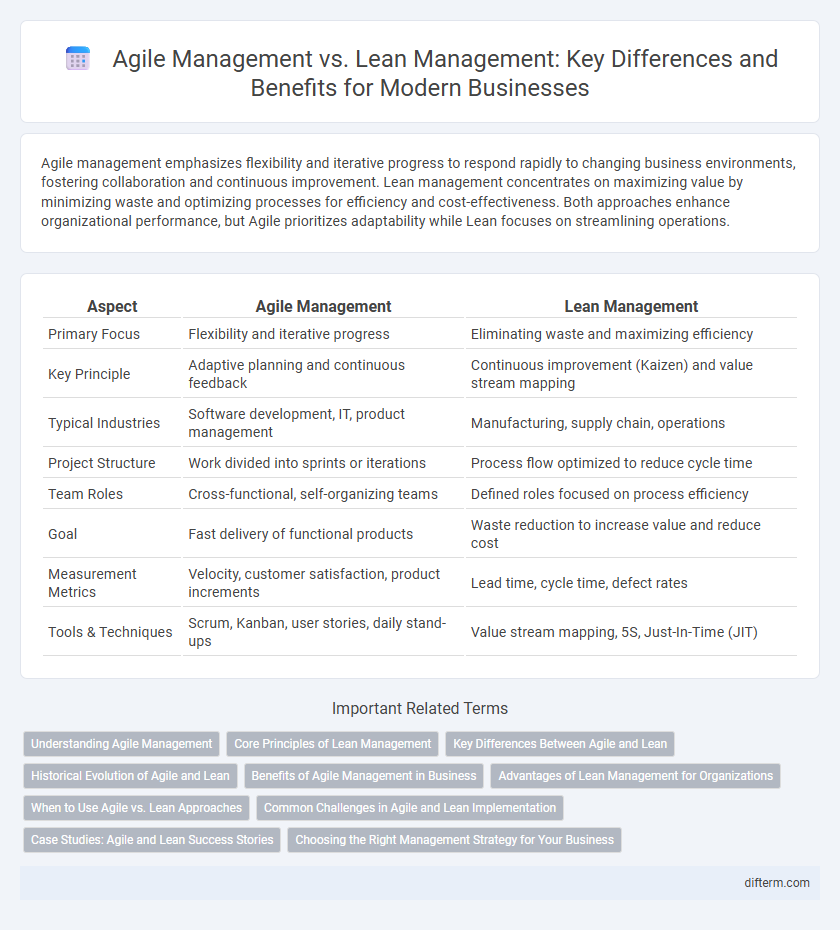Agile management emphasizes flexibility and iterative progress to respond rapidly to changing business environments, fostering collaboration and continuous improvement. Lean management concentrates on maximizing value by minimizing waste and optimizing processes for efficiency and cost-effectiveness. Both approaches enhance organizational performance, but Agile prioritizes adaptability while Lean focuses on streamlining operations.
Table of Comparison
| Aspect | Agile Management | Lean Management |
|---|---|---|
| Primary Focus | Flexibility and iterative progress | Eliminating waste and maximizing efficiency |
| Key Principle | Adaptive planning and continuous feedback | Continuous improvement (Kaizen) and value stream mapping |
| Typical Industries | Software development, IT, product management | Manufacturing, supply chain, operations |
| Project Structure | Work divided into sprints or iterations | Process flow optimized to reduce cycle time |
| Team Roles | Cross-functional, self-organizing teams | Defined roles focused on process efficiency |
| Goal | Fast delivery of functional products | Waste reduction to increase value and reduce cost |
| Measurement Metrics | Velocity, customer satisfaction, product increments | Lead time, cycle time, defect rates |
| Tools & Techniques | Scrum, Kanban, user stories, daily stand-ups | Value stream mapping, 5S, Just-In-Time (JIT) |
Understanding Agile Management
Agile Management emphasizes iterative development, continuous feedback, and adaptive planning to enhance collaboration and responsiveness in dynamic business environments. It prioritizes customer value and rapid delivery through cross-functional teams working in short cycles called sprints. Unlike Lean Management, which focuses primarily on eliminating waste and optimizing processes, Agile fosters flexibility and innovation to accommodate changing requirements and market demands.
Core Principles of Lean Management
Lean Management centers on maximizing value by eliminating waste, emphasizing continuous improvement, and fostering respect for people throughout all processes. Its core principles include defining value from the customer's perspective, mapping the value stream to identify and remove non-value-adding activities, creating smooth workflow, establishing pull systems to prevent overproduction, and pursuing perfection through iterative enhancements. These foundational elements drive efficiency, reduce costs, and improve product quality across various business operations.
Key Differences Between Agile and Lean
Agile management emphasizes iterative development, customer collaboration, and flexibility to rapidly adapt to changing project requirements, promoting cross-functional team autonomy. Lean management prioritizes waste reduction, process efficiency, and continuous improvement by identifying and eliminating non-value-added activities to optimize resource utilization. Key differences include Agile's focus on enabling adaptability and frequent delivery of functional products, while Lean centers on streamlining processes and maximizing overall operational efficiency.
Historical Evolution of Agile and Lean
Agile Management emerged in the early 2000s as a response to rigid software development methodologies, emphasizing iterative progress and customer collaboration rooted in the Agile Manifesto of 2001. Lean Management, tracing its origins to Toyota's manufacturing innovations in the mid-20th century, focuses on waste reduction and continuous improvement inspired by the Toyota Production System. Both methodologies evolved to enhance efficiency and adaptability, influencing diverse industries beyond their initial applications.
Benefits of Agile Management in Business
Agile Management drives faster product delivery and enhances adaptability by promoting iterative development and continuous feedback. It improves team collaboration and customer satisfaction through increased transparency and responsiveness to market changes. Emphasizing flexibility, Agile enables businesses to reduce risks and optimize resource allocation for dynamic project environments.
Advantages of Lean Management for Organizations
Lean Management enhances organizational efficiency by eliminating waste and streamlining processes, leading to reduced operational costs and faster delivery times. It fosters a culture of continuous improvement and employee empowerment, which improves product quality and customer satisfaction. By optimizing resource utilization and minimizing redundancies, Lean Management supports sustainable growth and competitive advantage in dynamic markets.
When to Use Agile vs. Lean Approaches
Agile management excels in environments requiring rapid adaptability and iterative progress, making it ideal for dynamic projects with evolving client needs such as software development and product design. Lean management is best suited for processes emphasizing efficiency and waste reduction, often applied in manufacturing and operational workflows where consistent quality and cost control are priorities. Selecting Agile or Lean depends on project complexity, team structure, and the balance between flexibility versus process optimization needs.
Common Challenges in Agile and Lean Implementation
Common challenges in Agile and Lean implementation include resistance to organizational change, lack of clear leadership, and insufficient training on methodologies. Teams often struggle with balancing flexibility and process discipline, leading to inconsistent delivery outcomes. Measuring performance and aligning Agile or Lean principles with existing corporate culture frequently hinder successful adoption and scalability.
Case Studies: Agile and Lean Success Stories
Agile Management case studies highlight companies like Spotify, which used iterative development and flexible team structures to accelerate product delivery and enhance customer satisfaction. Lean Management success stories include Toyota's implementation of just-in-time production and continuous improvement, resulting in significant cost reduction and operational efficiency. Both methodologies demonstrate how tailored approaches to process optimization drive measurable business performance improvements.
Choosing the Right Management Strategy for Your Business
Agile Management emphasizes flexibility and rapid iteration to adapt to changing customer needs, making it ideal for dynamic, innovation-driven industries. Lean Management focuses on eliminating waste and maximizing efficiency, which suits businesses aiming to enhance operational productivity and cost-effectiveness. Choosing the right strategy depends on your business goals, industry demands, and the need for speed versus process optimization.
Agile Management vs Lean Management Infographic

 difterm.com
difterm.com